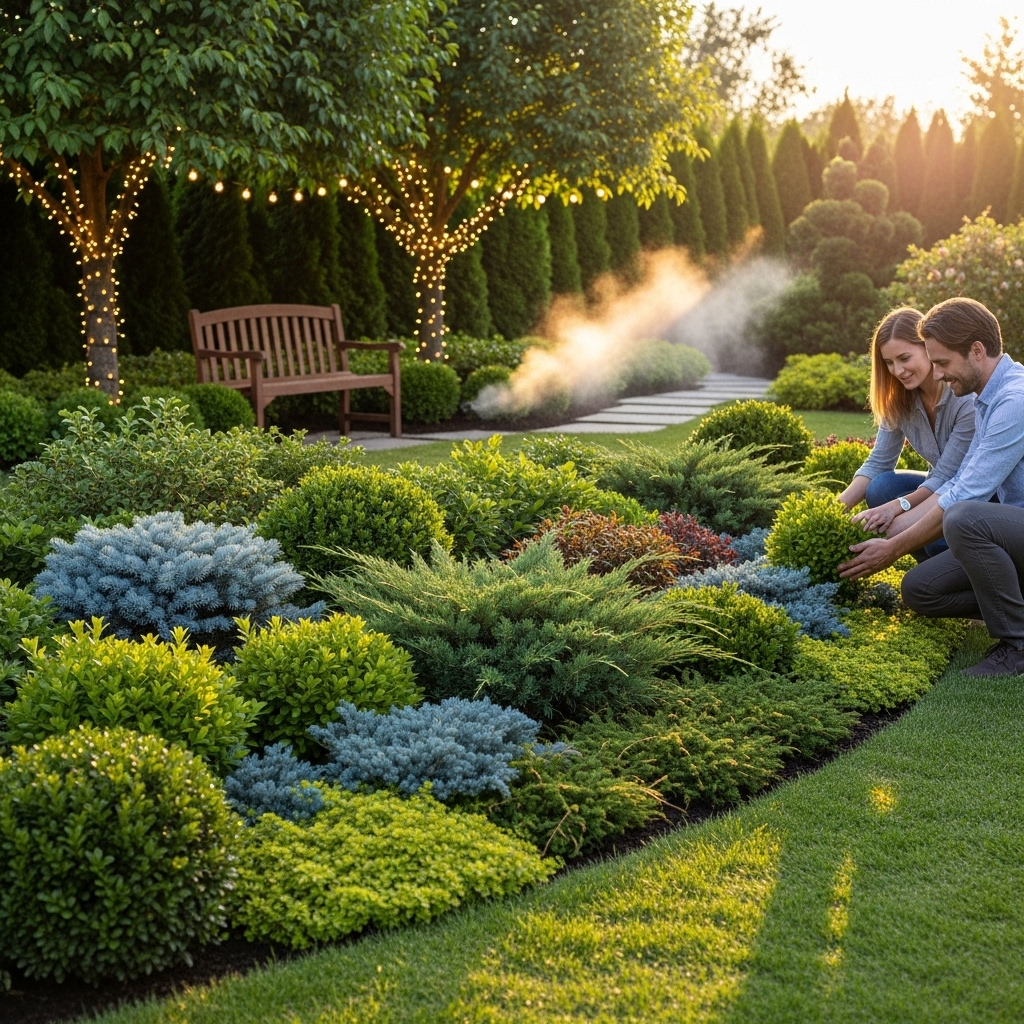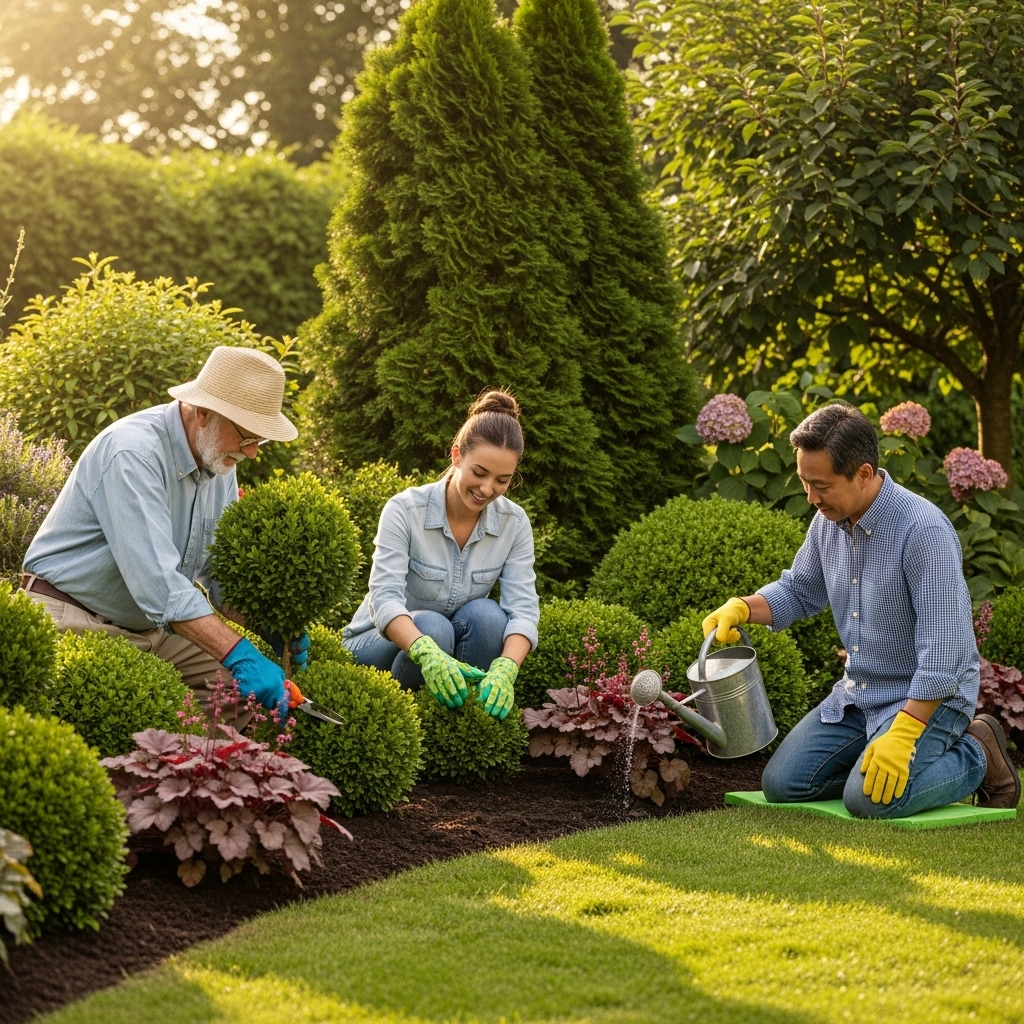Creating a lush, evergreen border in my garden has been one of the most rewarding experiences. I’ve discovered that low-maintenance evergreen plants not only enhance my landscape but also provide year-round beauty, making them the perfect choice for any garden enthusiast.
Choosing the Right Evergreen Border Plants

When I first embarked on my journey to establish an evergreen border, I quickly learned that the right selection of plants is crucial. The goal was to create a vibrant, low-maintenance landscape that would thrive regardless of the seasons. I considered various factors such as climate, soil conditions, and the overall aesthetic I wanted to achieve. My experiences have led me to a list of favorite evergreen plants that bring both beauty and ease to garden maintenance.
Understanding My Climate and Soil
The first step in my plant selection process was understanding the specific climate and soil conditions of my garden. I took the time to analyze whether I lived in a cooler area with harsh winters or a milder climate. This understanding allowed me to choose plants that would not only survive but flourish. I also evaluated the type of soil I had—whether it was sandy, clay, or loamy—because this would significantly influence my plant choices. For instance, I discovered that some evergreens prefer well-drained soil, while others thrive in richer, moisture-retentive environments.
Top Low-Maintenance Evergreens
As I explored various options, a few standout evergreens became my go-to choices for creating a border that requires minimal upkeep. Here’s a closer look at some of my favorites:
1. Boxwood (Buxus spp.)
Boxwoods are classic choices for borders. I love how they can be easily shaped into hedges or left to grow naturally for a more informal look. Boxwoods are hardy and can tolerate a range of soil types, but they do best in well-drained soil. I found that they thrive in full sun to partial shade, making them versatile for any part of my garden. Their rich green foliage remains vibrant throughout the year, providing a lush backdrop for seasonal flowers or ornamental plants.
2. Juniper (Juniperus spp.)
Junipers have become another staple in my evergreen border. They come in various shapes and sizes, from low-growing ground covers to taller upright varieties. I appreciate their drought-resistant nature, which means less watering on my part. The blue-green foliage of certain juniper varieties adds a unique color contrast to my garden, and their ability to spread or mound makes them perfect for filling in gaps. Plus, they require minimal pruning, which saves me time.
3. Holly (Ilex spp.)
Hollies bring an exciting element to any garden with their glossy leaves and vibrant berries. I’ve planted several varieties, including both evergreen types like the American Holly and the English Holly. They not only provide structure to my garden but also attract birds, which I love to watch. Hollies are adaptable to various soil types and require little maintenance, making them perfect for my busy lifestyle. I also appreciate their natural pest resistance, which means fewer chemicals in my garden.
4. Rhododendron and Azaleas
While not all rhododendrons are evergreen, many varieties are. I adore the stunning blooms these plants produce in the spring, and they continue to provide lush green foliage throughout the year. They prefer slightly acidic soil, which I’ve been able to achieve with some amendments. With their shade tolerance, I’ve found them to be a perfect choice for the shadier areas of my garden. They don’t require much pruning, which is a plus for my low-maintenance goals.
5. Arborvitae (Thuja spp.)
Arborvitae has been a game-changer for creating privacy in my garden. These tall, evergreen trees grow quickly and can be easily shaped to fit my desired height. They are perfect as a backdrop for shorter plants or to form a natural fence between properties. I appreciate their hardy nature and their resistance to many pests and diseases. Plus, they provide excellent year-round coverage, ensuring my garden feels alive even in winter.
Creating Visual Interest
Beyond just selecting the right plants, I’ve learned that creating visual interest in my evergreen border is essential. Combining different textures, colors, and heights can transform a simple row of evergreens into a dynamic landscape feature. For instance, I often pair the fine needles of junipers with the broad leaves of boxwoods. This contrast not only enhances the overall visual appeal but also keeps my garden vibrant and engaging throughout the year.
Moreover, I’ve found that using evergreens of varying heights can create a more layered look. Taller plants like arborvitae provide a backdrop, while shorter varieties like dwarf boxwoods fill in the foreground beautifully. This layering adds depth and dimension to my garden, making it feel more expansive and inviting.
As I continue to cultivate my evergreen border, I’m reminded of the beauty and tranquility that these low-maintenance plants bring to my outdoor space. With careful selection and design, I’ve managed to create a lush, year-round landscape that requires minimal effort yet offers maximum enjoyment. I look forward to sharing more about the upkeep and care of these remarkable plants in the next part of my gardening journey.
Maintenance Tips for My Evergreen Border

As I have enjoyed watching my evergreen border flourish, I’ve also come to realize that a little maintenance goes a long way in keeping these plants healthy and vibrant. While I initially sought low-maintenance options, I’ve discovered that some basic care routines can help ensure that my garden remains a stunning display throughout the seasons. Here are some of the key maintenance tips I’ve found particularly useful.
Watering Wisely
One of the primary aspects of maintaining my evergreen border is understanding the watering needs of each plant. Early on, I learned that while many evergreens are drought-resistant, they still require adequate moisture to establish their roots, especially during the first year after planting. I made it a habit to water deeply but infrequently, encouraging my plants to develop strong, deep root systems. In the summer months, I monitor the moisture levels more closely, especially during dry spells, and I’ve found that a layer of mulch not only conserves moisture but also suppresses weeds.
Mulching for Health
Speaking of mulch, I’ve become a strong advocate for its use in my garden. Applying an organic mulch layer around my evergreens has provided several benefits. It helps maintain consistent soil moisture and temperature, suppresses unwanted weeds, and as it breaks down, it enriches the soil. I often use shredded bark or wood chips, which not only look appealing but also blend well with the natural environment of my garden. Every spring, I make it a point to refresh the mulch, ensuring it remains effective throughout the growing season.
Fertilizing for Growth
While evergreens don’t require as much fertilization as flowering plants, I’ve found that applying a slow-release fertilizer in early spring gives my plants a much-needed nutrient boost. I opt for a balanced fertilizer that includes micronutrients to ensure that my evergreens remain vibrant and healthy. This practice has particularly benefited my rhododendrons and azaleas, which seem to respond well to the extra nutrients, producing stunning foliage and blooms.
Pruning Techniques
Another aspect of maintenance that I’ve embraced is pruning, though I do so sparingly. Most of my evergreen plants require minimal pruning, but I’ve found that regular light trimming helps maintain their shape and removes any dead or diseased branches. For my boxwoods, I tend to prune them in late spring after the last frost, allowing them to retain their shape while encouraging fresh growth. Understanding each plant’s specific pruning requirements has helped me keep my garden looking tidy without overdoing it.
Addressing Pests and Diseases
Despite the hardiness of evergreens, I’ve dealt with occasional pest issues. I’ve learned to keep a close eye on common pests such as scale, aphids, and spider mites. Regular inspections help me catch any infestations early. I prefer using natural remedies, such as neem oil or insecticidal soap, which are effective yet gentle on the plants. Additionally, I’ve taken to monitoring the overall health of my evergreens to catch any signs of disease early on, such as yellowing leaves or stunted growth, allowing me to take action before it becomes a larger problem.
Seasonal Care
As the seasons change, I’ve adapted my care routine for my evergreen border accordingly. In winter, I make it a priority to check for snow accumulation on my arborvitae and other tall evergreens, gently brushing off heavy snow to prevent breakage. During the late fall, I ensure that my evergreens are properly watered before the ground freezes, which helps them cope with the harsh winter conditions. I also keep an eye out for salt damage from de-icing agents used on sidewalks, and I adjust my watering practices in spring to help my plants recover from winter stress.
Enjoying the Fruits of My Labor
As I continue to care for my evergreen border, I often take time to simply enjoy the fruits of my labor. The tranquility and beauty that these low-maintenance plants provide have turned my garden into a personal sanctuary. Whether I’m sipping coffee in the morning sun or hosting friends for an evening gathering, I find immense satisfaction in the lush backdrop of greenery that surrounds me. Evergreens have not only transformed my landscape but also enriched my life, providing a constant reminder of nature’s beauty and resilience.
In the upcoming sections, I look forward to sharing how I incorporate seasonal blooms and other garden features to complement my evergreen border, allowing it to remain dynamic and inviting throughout the year.
Final Thoughts
Creating and maintaining an evergreen border has been a fulfilling journey filled with lessons about plant selection, care, and the joys of gardening. Emphasizing low maintenance while ensuring beauty has led me to appreciate the resilience of these plants, which not only thrive in my garden but also adapt beautifully to changing seasons. As I continue to explore new ways to enhance my garden, I remain excited about the endless possibilities that lie ahead.
